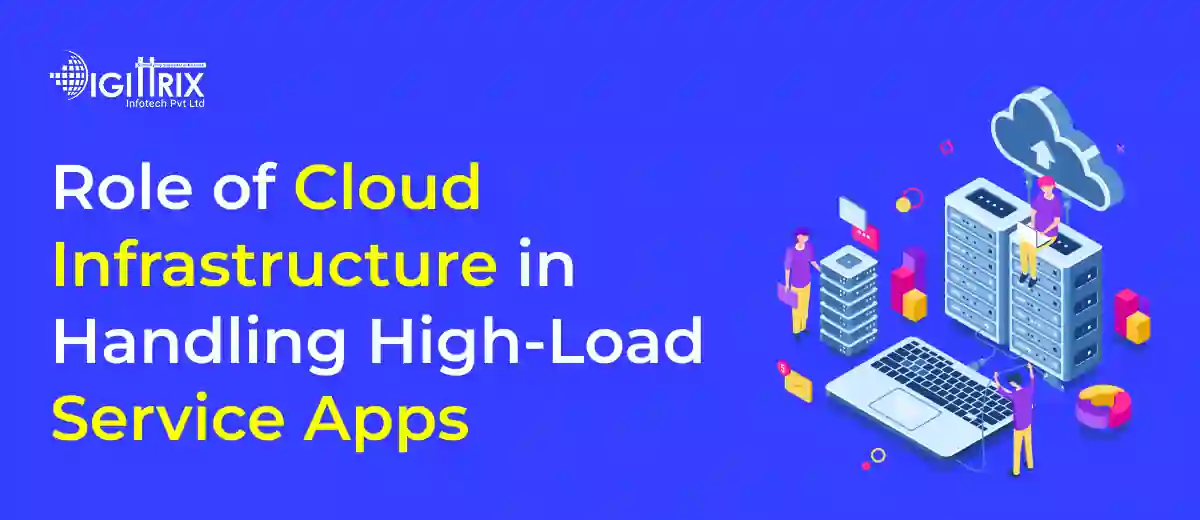Cloud infrastructure supports high-load service apps with scalable, secure, and cost-effective resources, ensuring uninterrupted performance during heavy traffic and rapid shifts in user demand.
Highlights
An enthusiastic developer and skilled business management expert with over a decade of experience in the field

In today’s digital market, many applications serve millions of active users each day. These platforms, often called High-Load Service Apps, require a robust technical foundation to handle large volumes of requests, store significant data sets, and respond quickly. Whether it’s an e-commerce platform during a seasonal sale, a ride-hailing service during peak times, or a video streaming platform during live events, the backend infrastructure must manage high traffic without slowing down or crashing.
This is where cloud infrastructure plays a crucial role. It provides flexible computing power, distributed storage, and on-demand resources that adapt to user demand. For businesses working with a mobile app development company or developing applications internally, cloud-based systems have become a vital option for managing large workloads.
Looking to create your own HVAC service app? Check Digittrix's complete guide to get started!
A High-Load Service App is designed to handle thousands or even millions of requests per minute. These apps manage tasks like online transactions, file uploads, live data processing, or interactive sessions without delays.
The main characteristics of such applications include:
The ability of these applications to stay operational during heavy traffic largely depends on the infrastructure they are hosted. That’s why businesses often opt for cloud solutions when looking for app development services for high-load projects.
Cloud infrastructure provides a virtual environment where resources such as servers, storage, and networking are managed over the internet. This arrangement is adaptable, enabling businesses to increase or decrease their computing capacity as required.
For a high-demand application, this flexibility offers a real advantage. When user numbers suddenly increase, such as during a new on-demand delivery launch or a holiday sale, the cloud can allocate additional resources instantly. This helps prevent delays, timeouts, and errors.
For on-demand app development, where sudden surges in user activity are common, cloud infrastructure allows companies to keep performance steady without overspending on physical hardware.
One of the main advantages of cloud systems is scalability. Developers and system administrators can quickly boost server capacity during traffic spikes and reduce it when demand drops. This feature helps prevent unnecessary costs on idle resources and keeps expenses in check.
High-load services cannot afford downtime. Cloud infrastructure offers distributed server locations, so if one data centre encounters problems, another can take over without interruption. This guarantees services run smoothly.
Instead of purchasing and maintaining large physical servers, businesses can rent computing power from cloud providers. Payments are typically based on actual usage, which is especially helpful for seasonal or event-driven high-load periods.
Cloud providers often run data centres in different regions. This allows a mobile app development team to host the application closer to their target audience, reducing latency and improving user experience.
One of the biggest challenges for high-traffic apps is managing unpredictable demand. An unexpected social media trend, a special promotion, or sudden popularity can draw in many users at once. Without the right infrastructure, servers might crash, leading to poor user experiences.
Here’s how cloud systems manage it:
Cloud platforms can automatically adjust the number of active servers according to real-time traffic. If the app detects a surge in users, new virtual machines are activated to share the load.
Traffic is distributed across multiple servers to prevent any single machine from becoming overloaded. This helps ensure steady performance.
Frequently accessed data is stored in memory caches so that repeated requests are responded to swiftly without putting extra strain on the database.
Multiple copies of the database are stored across various locations to optimise data reading and writing efficiently.
These processes are especially helpful for Android app developer teams creating apps with high user engagement, as they prevent delays during busy periods.
Handling large traffic volumes also involves managing increased security risks. Cyberattacks like Distributed Denial of Service (DDoS) can deliberately overload servers. Cloud platforms offer security measures such as:
When a mobile app development company uses cloud infrastructure, it can put these protections in place to keep user information and business data secure.
On-demand app development involves creating services that respond quickly to user requests, such as taxi booking, food delivery, or home services. These apps often encounter unpredictable and varying loads.
Cloud infrastructure supports on-demand applications by:
These features allow even smaller businesses to compete with larger brands, as they can handle high demand without needing to invest in expensive, dedicated hardware.
Today’s high-load apps often run across multiple platforms, including Android and ios. An Android App Developer and an iOS App Developer working on the same project can utilise shared cloud services for:
This approach allows the same backend to support various device types, saving time and resources.
One advantage of cloud platforms is their integrated monitoring. Administrators can monitor server performance, database response times, and user activity. This data assists developers:
When app development services include performance monitoring, issues can be fixed before they impact users, ensuring a smooth and dependable experience.
Imagine an e-commerce app development for a major sales event. Without cloud infrastructure, the business would need to buy extra servers in advance, keep them running all year, and still risk running out of capacity during the sale.
With cloud hosting:
This is a great example of how cloud systems help businesses handle high demand without overextending resources.
When selecting a cloud provider for a High-Load Service App, consider:
These points assist businesses in choosing a platform that fits their technical needs and growth strategies.
The future of cloud systems for high-load applications is likely to include:
These trends will further simplify operations for iOS app developers and Android teams, providing them with more flexibility and control.
Concerned about data breaches? Check Digittrix's simple security tips to protect your business!
The role of cloud infrastructure in managing high-load service application operations cannot be overstated. It provides scalability, cost efficiency, and the capacity to maintain performance even during sudden traffic surges. Businesses investing in modern cloud solutions gain the ability to serve more users, secure their data, and ensure continuous availability.
Whether working with a mobile app development company or building systems in-house, cloud-based resources have become vital for competitive performance. By combining robust app development services with flexible cloud hosting, companies can manage high traffic without compromising speed or reliability.
From on-demand app development projects to large-scale e-commerce systems, cloud technology offers the flexibility needed in today’s rapidly changing digital environment. With the combined skills of an Android App Developer and an iOS App Developer, businesses can create applications that perform reliably, handle large user loads, and expand smoothly over time.
Planning to launch a high-performance app capable of supporting thousands of users at the same time. Digittrix specializes in developing powerful and scalable applications using advanced cloud infrastructure technologies like AWS, Google Cloud, and Microsoft Azure. Whether your app needs to handle heavy traffic during peak hours, process large data volumes, or deliver quick responses worldwide, we design solutions that maintain consistent performance.
At Digittrix, we integrate key features like auto-scaling, load balancing, secure data storage, and global server distribution to maintain your application’s stability and responsiveness during high demand. With over 14 years of experience in mobile app development and expertise in creating high-load service apps, our team knows how to build systems that meet your business needs and growth plans.
Start building your next high-capacity app today. Call us at +91 8727000867 or email digittrix@gmail.com to organize a free consultation with our development specialists.

Do you need help in Mobile App development?




Join over 1500+ businesses we've already helped!
Beauty App Development: Tips to Grow Your Business Through an App & Cost in India (2026)
It describes an application that manages many users and requests simultaneously without slowing down or crashing.
Cloud platforms can quickly add more resources when demand increases, maintaining performance stability.
Yes, because you only pay for what you use instead of purchasing and maintaining additional hardware.
Yes, a single cloud backend can efficiently serve both mobile and desktop users.
Most providers employ encryption, backups, and other measures to ensure stored information remains secure.

©2026Digittrix Infotech Private Limited , All rights reserved.